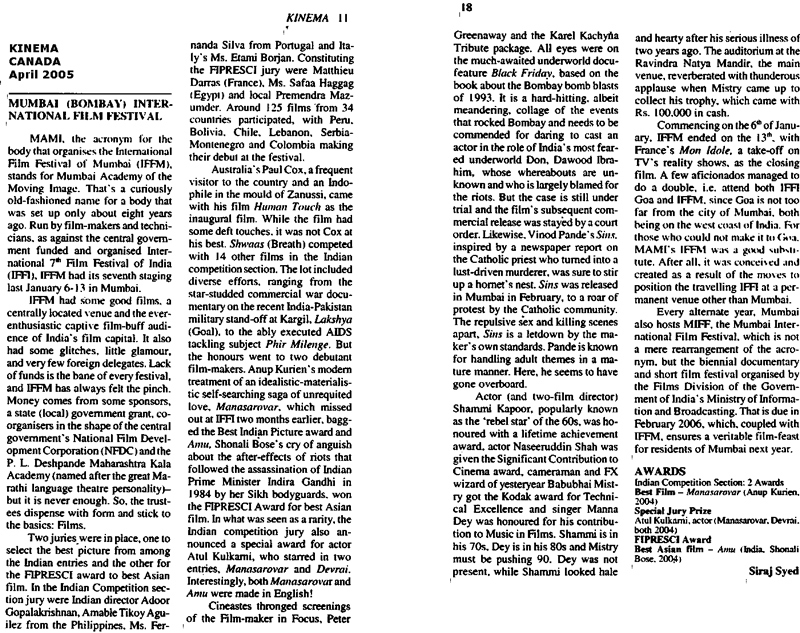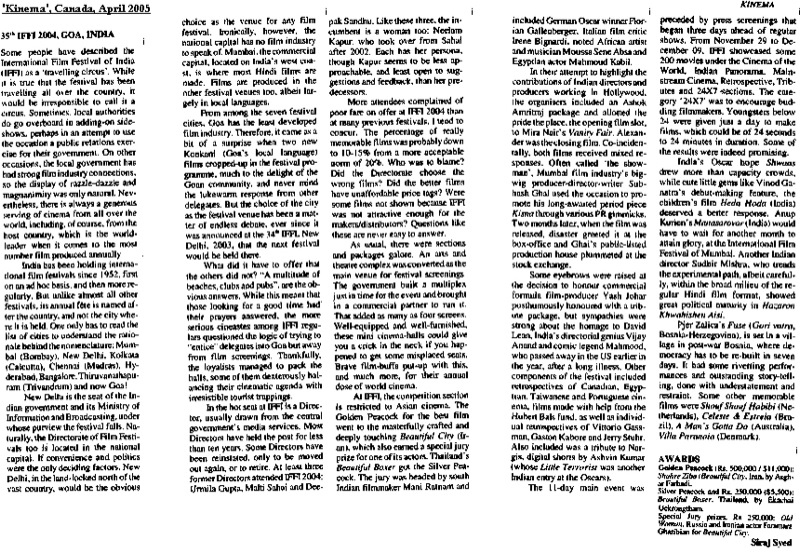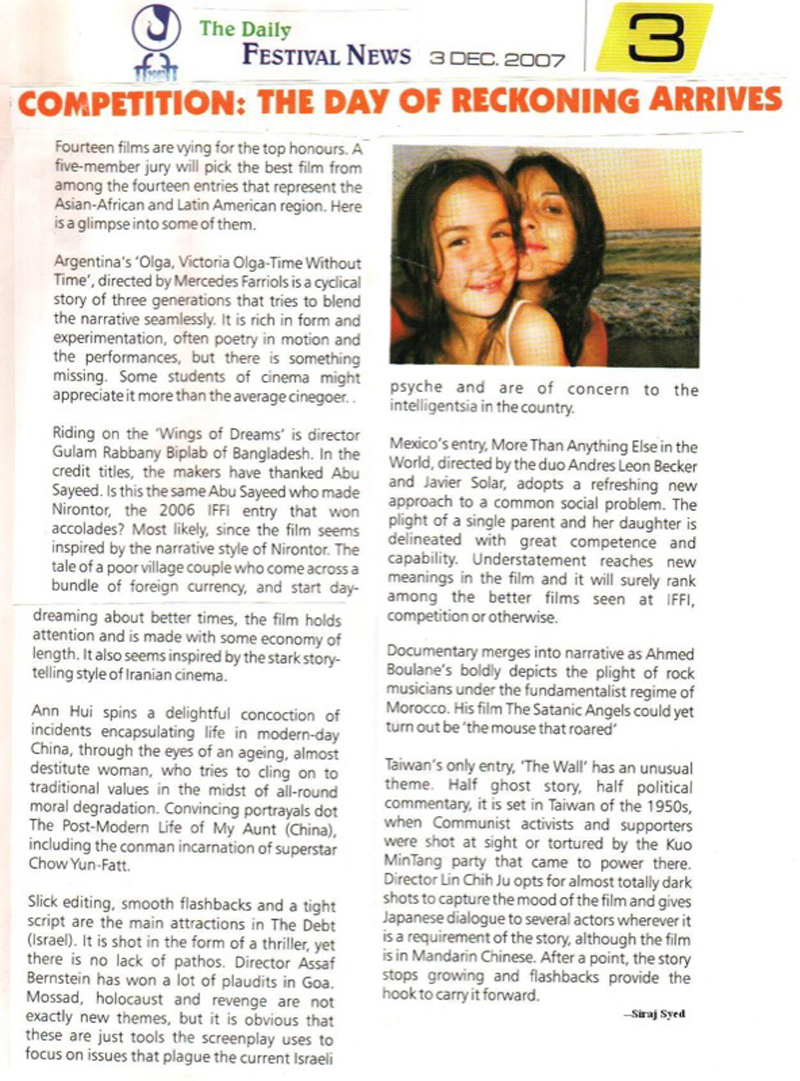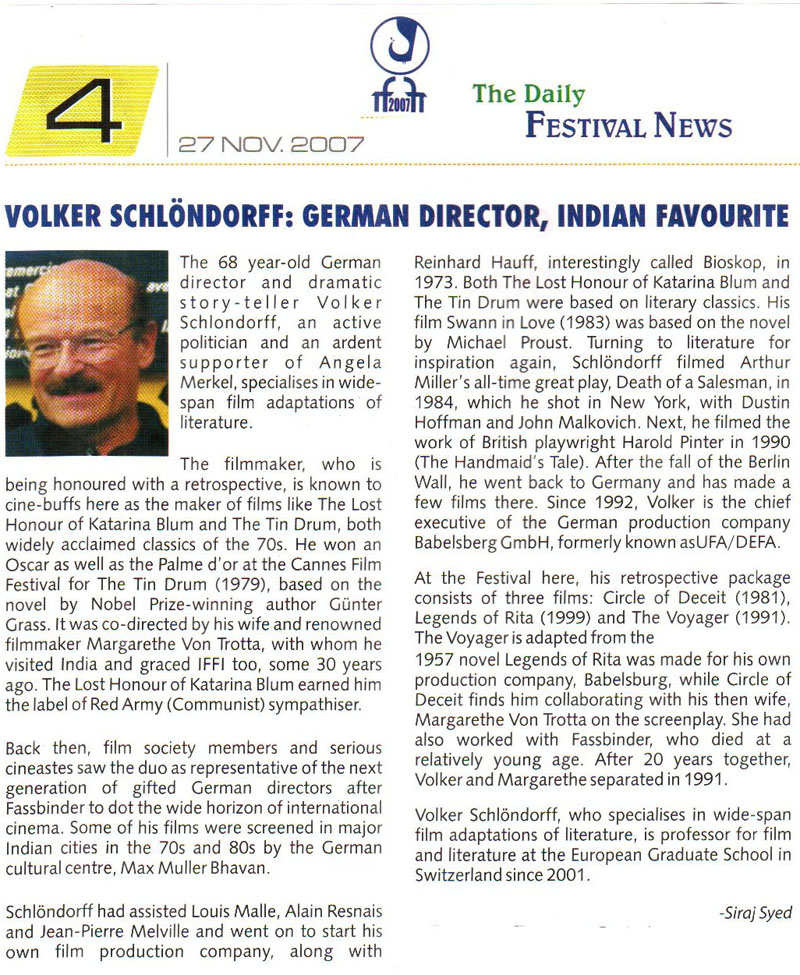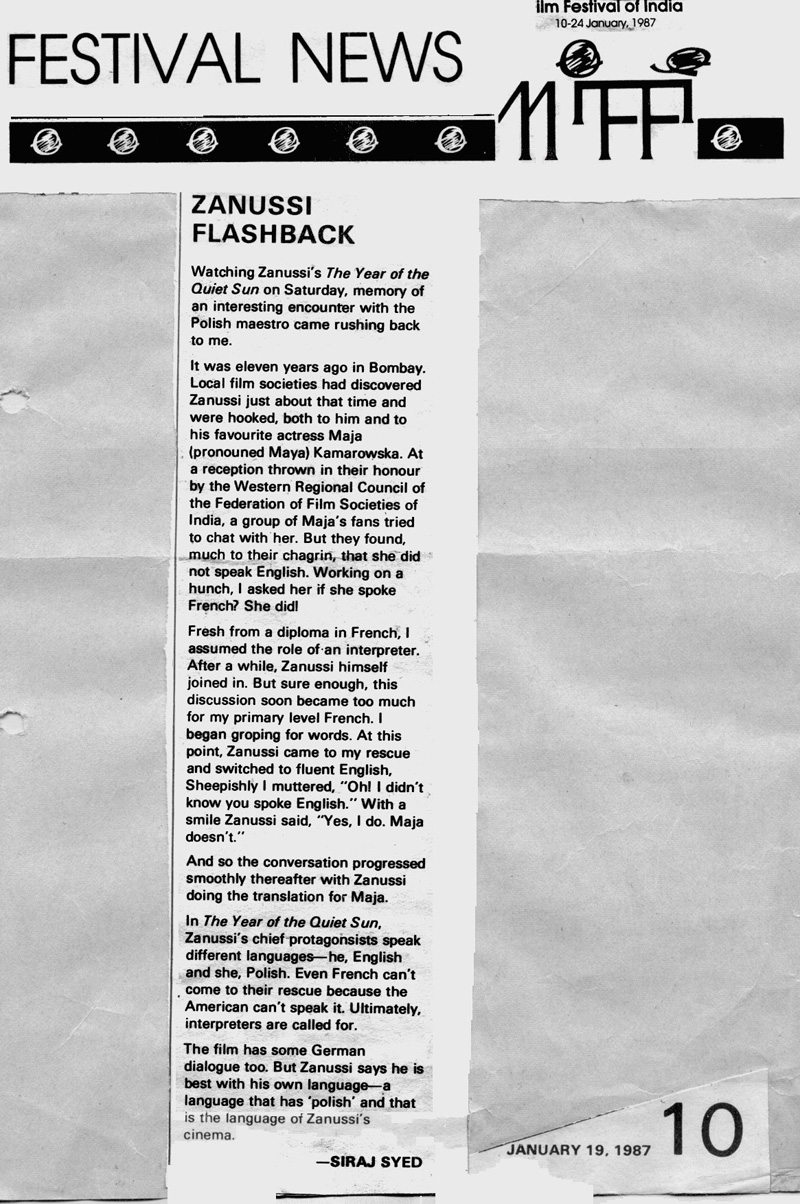|
|
||
|
Pro Tools
FILMFESTIVALS | 24/7 world wide coverageWelcome ! Enjoy the best of both worlds: Film & Festival News, exploring the best of the film festivals community. Launched in 1995, relentlessly connecting films to festivals, documenting and promoting festivals worldwide. Working on an upgrade soon. For collaboration, editorial contributions, or publicity, please send us an email here. User login |
Ben Hur, Review: Chariots for hire
Ben Hur, Review: Chariots for hire What do you remember about the 1959 screen version of the 1880 story? Nothing, unless you are a Senior Citizen, even if the Indian release was probably two years later than the Hollywood opening. I remember the chariot race, with Charlton Heston as Judah Ben-Hur and Stephen Boyd as Messala. Edge of the seat stuff, especially Messala. The sub-text of Christ, Christianity, Judaism, and the Roman Empire’s sadistic tyranny, was lost on the bunch of school-kids, who were officially taken to watch the film, at Bombay’s premium Metro cinema. Metro, because it was then owned by Metro Goldwyn Mayer (MGM), the company that had produced the film. It is a new millennium, and MGM is in deep financial trouble. Metro, Mumbai, was sold off some 25 years ago, and the company itself went bankrupt some years later. In a phoenix like revival, MGM emerged two years ago, after co-financing its franchises, like James Bond and Hobbit, and a few remakes. Large sums of money came in. And along with the moolah came to idea of re-making Ben Hur. Not really, though. MGM had produced the two earlier versions of the film, in 1925 and 1959. The latter, directed by Oscar veteran William Wyler, got almost all the Oscars on offer that year. Just for the record, it was filmed in 1907 too, and the first stage performance of Ben Hur: A Tale of the Christ, was held in 1889. But in 1980, the rights of this subject were sold to Ted Turner. What MGM was now looking at was a fresh adaptation of the 1880 novel by Lew Wallace, done by Keith Clarke. And Paramount was to come in as joint production house. Ben Hur is a Tale of the Christ, as the title of the 136 year-old novel confesses. There is an elaborate tale woven around Christ and his times, and the Messiah is not the star of the film, yet the sub-text is inescapable. No, it is not a sub-text, rather a subtle device used to preach the message of non-violence and reconciliation in the region of Antioch, Judea, Bethlehem and Nazareth of 2,000 years ago, in the last few years of Jesus Christ, the divine carpenter’s life. Judah Ben-Hur, of Jewish princely heritage, and his adopted brother, Messala, the grandson a of disgraced Roman soldier, grow up as real brothers, with a passion for horses and horse-riding. One day, Messala says that he will never achieve the name and fame that he desires, by staying with the Ben-Hur family, and leaves, to join the Roman army. A gutsy warrior, he does well on the battle-field, and is regularly promoted. Judah writes to him often, but he never replies. Years later, Messala calls Judah, and they meet. Messala, who is now assisting the military administration of the province, wants Judah’s help in governing, and also the names of “trouble-makers”, who oppose Roman rule. Though he is harbouring a wounded rebel, Judah does not advocate armed resistance. One day, when the new Roman governor is leading a horse-back army procession, in a show of strength, the rebel shoots an arrow, which just misses its mark. The Governor escapes unhurt, but another soldier is killed. Swinging into action, Messala and his men raid Judah’s home. The rebel, and a sister of Judah, manage to flee. Judah begs for mercy, owning up to the crime, but the whole family is dragged away. Jesus offers water to the accused man. Later, he is forced to row boats in the galleys, as a slave. Destiny will intervene in the form of a rich African Shiek (Sheikh?, pre-Islamic, of course) Ilderim, who trains horses and bets at chariot races, and bring the two once inseparable ‘siblings’ face-to-face, in a chariot race, that could mean death, or salvation. Two obvious questions arise. What are the differences between the 1959 film and the 57 years later edition? How much does this tale differ from Lew Wallace’s novel? Let’s get some answers. Keith Clarke (co-writer, The Way Back, the Peter Weir directed survival story), and his wife, producer Joni Levin (Ben Hur, among others), were looking for a story about forgiveness. After researching subjects about the Palestinian-Israeli conflict and the revolt in Belfast, they narrowed down on the Truth and Reconciliation Commission, in South Africa, which was established to ease the pain of black and white segregation—apartheid. One Easter, Ben-Hur came on TV, and his wife looked at Keith and said, “What about this?” Once Clarke and Levin decided on the story of Ben-Hur, Clarke read the original source material, Lew Wallace’s 1880 book. Clarke felt, “The bigger the sin, the greater the forgiveness.” So, he made them half-brothers, though they were only friends in the 1959 film. John Ridley IV (Three Kings, 12 Years a Slave) was later brought on to work on the script. There are many more changes. Here’s one major one: In the original story, Judah accidentally knocks over a large flower pot that injures the governor. There is no recuperating rebel shooting an arrow. Then there is the end...but, obviously, I cannot reveal the end. Two friends/brothers in a face-off is a plot that has had several hundred variations of the theme. Ben-Hur is probably the prototype. Having the protagonists as brothers, albeit adoptive, is not a bad idea at all. What needed more fleshing out was the adoption itself and a peep into Messala’s blood family. Getting a rebel to shoot at the governor seems too obvious a ploy to be appreciated and the rebellion angle itself is only half-heartedly developed. Women get more footage---not more effective parts, though. When it comes to Christ, there is both too little and too much. You cannot have Jesus Christ as a side character, yet any more of him would have taken the story completely from its main characters. None of these changes would matter to someone who is seeing the tale unfold for the first time. All the additions and modifications have been seamlessly stirred and shaken. It’s a good script that could have been much better. Timur Nuruakhitovich Bekmambetov might be a mouthful, but the middle name of this Kazakhstan/Uzbekistan prodigy is never mentioned. Beginning with Escape from Afghanistan/Peshawar Waltz, he went on to make the much talked about Abraham Lincoln: Vampire Hunter. A Soviet director at the helm of a Roman-Jew legend that spreads the message of Christ, with a British-American-Brazilian-Israeli-Iranian cast is a rarity that cannot escape notice. Due credit to him for sticking to reality for the greater part, eschewing miracles, and restricting CGI to a minimum. Doing the chariot race differently from the earlier version was an invitation to ridicule, yet he manages to hold his horses. At the same time, Bekmambetov just falls short of capturing your imagination in the 123 minutes that he is given, a full 89 minutes less than the 1959 outing. I realise that just additional length means nothing, and a log film is more likely to get boring than a shorter version. Nevertheless, the way the scenario was unravelling, maybe little more time would have allowed the pieces to enmesh better. Initially chosen for Messala, Jack Huston (American Hustle, Hail Caesar, Pride and Prejudice and Zombies) and Tobias (Toby) Alistair Patrick Kebbell (The Sorcerer’s Apprentice, Wrath of the Titans, Dawn of the Planet of the Apes) are both British and both competent. Jack sometimes appears unduly helpless while Toby seems a tad uncomfortable doing the evil stuff. If you have to compare, Charlton Heston (lived to be a grand old man) and Stephen Boyd (died at 45) had a much stronger screen presence. Heston>Huston, anyone? Rodrigo Santoro (300: Rise of an Empire, Pelé: Birth of a Legend) is Christ, as typical as they come, blessed by no less a person than Pope Francis. Nazanin Boniadi (Iranian/American/British; Iron Man, The Next Three Days) as Esther, Ayelet Zurer (Munich, Angels and Demons, Man of Steel) as Naomi and Sofia Black D'Elia as Tirzah provide average support. James Cosmo as Quintus Arius is menacing. Dread locks do not help Morgan Freeman, who, at 79, has been used superficially for the umpteenth time. As narrator too, he is just himself. A highly talented veteran, he surely deserves better. Several characters speak with a put-on, bass, granular voice, probably under the time-beaten belief that all historical personalities spoke in this manner. Rating: ** ½ Trailer: https://youtu.be/gLJdzky63BA Summary of the original story Judah Ben-Hur is a 17 year old Jew at the time of the roman occupation of Judea. His boyhood friend, Messala, comes back from Rome, to help to govern the province of Judea. But he is no longer the Messala Judah once knew. He is a Roman now. Judah realises that they can no longer be friends, and he leaves him. Later that day, he stands on the roof of his house, to watch the new governor parade in. He accidentally knocks a tile from the roof and hits the governor on the head. The governor, being slightly furious at Judah, sends him to the galleys, and his mother and sister are sent to a rather unpleasant prison. All of their possessions, including their house, are taken by the Romans. Judah is furious at Messala for doing this, and vows to kill him. Three years later, Quintis Arrius takes over the ship that Ben-Hur is rowing in. They are attacked by pirates (changed to Greek rebels in the film), and Ben-Hur saves Arrius' life. Arrius is very grateful to Ben-Hur, and adopts him, making him the heir to all his property. (A different version in 2016) Five years later, Judah arrives in Antioch. There, he meets a wealthy merchant named Simonides and his daughter, Esther. Ben-Hur thinks she is very pretty, but he has more important things to think about. He finds out that Simonides is his father’s servant and he asks him where is mother and sister are. Simonides does not know where they are, and sorrowfully tells Ben-Hur that he does not know. Ben-Hur goes away and meets Shiek Ilderim. Shiek Ilderim owns a very fine team of horses and Ben-Hur is an expert charioteer. He asks if he can be Ilderim's charioteer. He knows that Messala will also be in the race and he wishes to humiliate him by winning. There, he meets an Egyptian named Balthazar and his beautiful daughter, Iras. Balthazar was one of the three wise men, and he tells Judah that he should forgive Messala. Judah is not ready to do that. He is quite taken with the beautiful Iras and spends as much time as he can with her. When the day of the chariot race arrives, people from all over the world are there. For a long time Messala has the lead. But he was too close to the wall. His chariot hits the wall and he falls out. Ben-Hur wins the race. Messala has severely injured his legs, and has lost all his fortune on a bet he made that he would win the raced against Judah. After the chariot race, Judah continues his search for his mother and sister. He finds out that they are lepers, and believes they have been stoned. So he follows Jesus and begins to gather followers for his army. Amrah, an old servant of the Hurs, knows where Tirzah and her mother are, and she brings food to them every day. She hears Judah talking about how Jesus cured lepers, and she brings Tirzah and her mother to a road which Jesus will use to get to Jerusalem. Jesus cures them. Ben-Hur, who was following Jesus, sees them and is reunited with his family. That Friday, he follows Jesus up to where he will be crucified. While he watches along with thousands of other people, he finally understands that Jesus will not have his kingdom on earth, but in heaven. Five years later, Judah Ben Hur is married to Esther. 20.08.2016 | Siraj Syed's blog Cat. : Charlton Heston Jack Huston Jesus Christ John Ridley IV Keith Clarke Lew Wallace MGM Morgan Freeman Nazanin Boniadi paramount Peter Weir RODRIGO SANTORO Stephen Boyd Toby Kebbells William Wyler Hollywood
|
LinksThe Bulletin Board > The Bulletin Board Blog Following News Interview with IFTA Chairman (AFM)
Interview with Cannes Marche du Film Director
Filmfestivals.com dailies live coverage from > Live from India
Useful links for the indies: > Big files transfer
+ SUBSCRIBE to the weekly Newsletter Deals+ Special offers and discounts from filmfestivals.com Selected fun offers
> Bonus Casino
User imagesAbout Siraj Syed Syed Siraj Syed Siraj (Siraj Associates) Siraj Syed is a film-critic since 1970 and a Former President of the Freelance Film Journalists' Combine of India.He is the India Correspondent of FilmFestivals.com and a member of FIPRESCI, the international Federation of Film Critics, Munich, GermanySiraj Syed has contributed over 1,015 articles on cinema, international film festivals, conventions, exhibitions, etc., most recently, at IFFI (Goa), MIFF (Mumbai), MFF/MAMI (Mumbai) and CommunicAsia (Singapore). He often edits film festival daily bulletins.He is also an actor and a dubbing artiste. Further, he has been teaching media, acting and dubbing at over 30 institutes in India and Singapore, since 1984.View my profile Send me a message The EditorUser contributions |



















